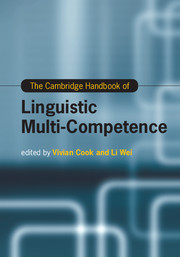Crossref Citations
This Book has been
cited by the following publications. This list is generated based on data provided by Crossref.
TYLER, ANDREA
and
ORTEGA, LOURDES
2016.
Usage-based approaches to language and language learning: an introduction to the special issue.
Language and Cognition,
Vol. 8,
Issue. 3,
p.
335.
2016.
A Transdisciplinary Framework for SLA in a Multilingual World.
The Modern Language Journal,
Vol. 100,
Issue. S1,
p.
19.
Gass, Susan
2016.
The path I took.
Language Teaching,
Vol. 49,
Issue. 4,
p.
578.
Brown, Amanda
and
Ruiz, Heather
2016.
Equity and enrichment in the TESOL practicum.
ELT Journal,
p.
ccw092.
Piccardo, Enrica
2017.
Plurilingualism as a Catalyst for Creativity in Superdiverse Societies: A Systemic Analysis.
Frontiers in Psychology,
Vol. 8,
Issue. ,
Ó MURCHADHA, NOEL
and
FLYNN, COLIN J.
2018.
Educators’ Target Language Varieties for Language Learners: Orientation Toward ‘Native’ and ‘Nonnative’ Norms in a Minority Language Context.
The Modern Language Journal,
Vol. 102,
Issue. 4,
p.
797.
Wei, Li
2018.
Translanguaging as a Practical Theory of Language.
Applied Linguistics,
Vol. 39,
Issue. 1,
p.
9.
Gass, Susan
2018.
Coda 1 World Englishes and Second Language Acquisition: Working towards a common goal.
World Englishes,
Vol. 37,
Issue. 1,
p.
120.
Wei, Li
and
(Jenifer) Ho, Wing Yee
2018.
Language LearningSans Frontiers: A Translanguaging View.
Annual Review of Applied Linguistics,
Vol. 38,
Issue. ,
p.
33.
Singleton, David
and
Pfenninger, Simone E.
2018.
L2 acquisition in childhood, adulthood and old age.
Journal of Second Language Studies,
Vol. 1,
Issue. 2,
p.
254.
Gross, Barbara
and
Dewaele, Jean-Marc
2018.
The relation between multilingualism and basic human values among primary school children in South Tyrol.
International Journal of Multilingualism,
Vol. 15,
Issue. 1,
p.
35.
De Houwer, Annick
and
Ortega, Lourdes
2018.
The Cambridge Handbook of Bilingualism.
Ortega, Lourdes
2018.
Ontologies of language, Second Language Acquisition, and world Englishes.
World Englishes,
Vol. 37,
Issue. 1,
p.
64.
Putnam, Michael T.
Carlson, Matthew
and
Reitter, David
2018.
Integrated, Not Isolated: Defining Typological Proximity in an Integrated Multilingual Architecture.
Frontiers in Psychology,
Vol. 8,
Issue. ,
Barratt, Leslie
2018.
The TESOL Encyclopedia of English Language Teaching.
p.
1.
CARLSON, MATTHEW T.
2019.
Now you hear it, now you don't: Malleable illusory vowel effects in Spanish–English bilinguals.
Bilingualism: Language and Cognition,
Vol. 22,
Issue. 5,
p.
1101.
Thompson, Amy S.
2019.
The Palgrave Handbook of Motivation for Language Learning.
p.
641.
Vettorel, Paola
2019.
Communication strategies and co-construction of meaning in ELF: Drawing on “Multilingual Resource Pools”.
Journal of English as a Lingua Franca,
Vol. 8,
Issue. 2,
p.
179.
Wildsmith-Cromarty, Rosemary
and
Balfour, Robert J.
2019.
Language learning and teaching in South African primary schools.
Language Teaching,
Vol. 52,
Issue. 3,
p.
296.
Iwasaki, Noriko
and
Kumagai, Yuri
2019.
Reconceptualizing Connections between Language, Literacy and Learning.
Vol. 39,
Issue. ,
p.
165.



